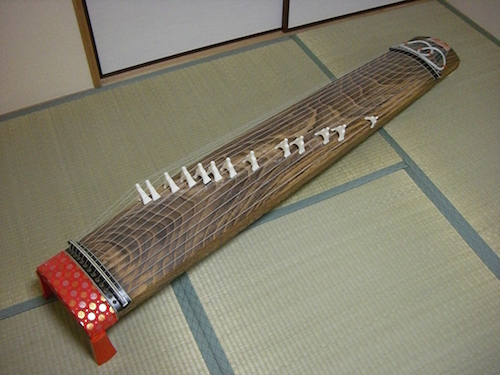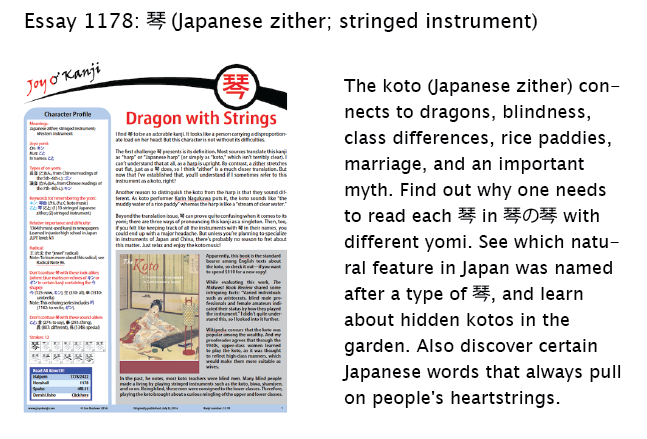Plucked from a Zither
With Joy o' Kanji, I'm creating something like an encyclopedia, so I learn about all the topics associated with a particular kanji. I love that. But then there's a bonus that surprises me every time. I also find out about countless things tangentially related to the subject. Today I'll share a random sampling of discoveries plucked from the new essay on 琴 (Japanese zither; stringed instrument; Western instrument). That kanji appears in the names of many instruments, but fundamentally people associate it with this one, the koto:

First, a Quiz
I'll present two of the findings in the form of a quiz. What do you think these terms could mean:
1. 稽古 (けいこ) to think about + old
a. reminiscing
b. practice
c. aging
d. dwelling on something
2. 裏付けがある (うらづけがある) back + attached
a. backdated
b. back stabbing
c. emotionally supported
d. supported by evidence
I'll block the answers with a photo containing 稽古—and if you're adept, maybe you can figure out its meaning from the context!
Photo Credit: Eve Kushner
1.b. 稽古 (けいこ: to think about + old) means "practice, rehearsal; learning," as in practicing the koto. The term 稽古 appears in two photos in essay 1178, including the very cool one above of a scroll promoting koto lessons. (The koto-scroll connection is lost on me.)
As to why the two kanji combine to mean "practice," Kanjigen says that 稽古 primarily means "to think about and investigate what happened in the past," which gave rise to a second definition, "to study or learn."
2.d. 裏付けがある (うらづけがある: back + attached) means "supported by evidence." Kojien says that 裏付け means “assurance; security” because in the Muromachi era (1333–1573), a debtor who paid the money he owed would put his seal (his stamped signature) on the back of a wooden tally (a symbol of an IOU) as proof of payment.
Okurigana Rules
In essay 1178, 裏付けがある pops up in a book title that also includes this figurative term:
心の琴線 (こころのきんせん: heartstrings; innermost soul)
heart + heartstrings (last 2 kanji)
An essay by 寺田寅彦 (てらだ とらひこ: 1878–1935, in which 寅 and 彦 are non-Joyo) contains that expression in this phrase:
それが生徒の心の琴線に共鳴を起させる
it really resonates with the students’ feelings
生徒 (せいと: student); 共鳴 (きょうめい: resonance); 起こす (おこす: to arouse, shown here in its causative form)
The essay came out in 1921, and the okurigana of the verb at the end matches the era in which the author wrote this sentence. Nowadays, 起こさせる is the causative form of 起こす.
As I learned, okurigana rules have changed over the years. When Professor Terada wrote his essay, okurigana covered less of a word than is the case today. That changed during the 1960s and 1970s when the government announced a new okurigana policy. Go figure!
Counting Kotos
I know someone with the surname Coto, so "Counting Kotos" sounds funny to me. I can go as high as one but no further!
If we're talking about the instrument, though, this is how you count them:
一面の箏 or 一面の琴 (いちめんのこと: one koto)
1 + counter for objects with flat surfaces + koto
二面の箏 or 二面の琴 (にめんのこと: two kotos)
2 + counter for objects with flat surfaces + kotos
What?! The face kanji 面 is a counter for objects with flat surfaces?! Yes. In fact, Spahn and Hadamitzky's Kanji Dictionary includes a list of counters and indicates that -面 is a counter for mirrors, newspaper pages, pools, ski slopes, tennis courts, and cellos—but not violins! One counts violins with the non-Joyo -挺, also a counter for guns, inksticks, palanquins, and rickshaws! Or so says Denshi Jisho; Spahn and Hadamitzky confirm only the gun part in their list of counters.
Shrine Nomenclature
In Japan, all shrines that worship a particular god share a name. For instance, in Kagawa Prefecture on Shikoku, a famous shrine is formally called 琴平宮 (ことひらぐう), though it's more popularly known as 金刀比羅宮 (ことひらぐう) or 金比羅宮 (こんぴらぐう). The shrine sits on a mountain named 琴平, which has a flat (平) top and is filled with trees. Whenever the wind blows and shakes the branches, they sound like a koto (琴)—hence the name, according to one site.
Most of that is an aside! My actual point is that the shrine in Kagawa is the head shrine worshipping the god 大物主 (おおものぬし). Other shrines with 琴平 in their names (such as one on Sado Island) worship the same god.
I had no idea such a system existed! How very organized!
Etymological Consistency
Speaking of consistency, even if various ancestral shapes for one character are wildly different, one should be able to explain them all with a consistent etymological theory. That's a tall order! And yet that's what Henshall strives for with his interpretations of these two ancestral shapes of 琴, which I found on Richard Sears's page:


They look nothing alike, but Henshall provides a unified theory.
After all my years thinking about etymology, and all the times I've seen an array of dissimilar old shapes on one of Sears's etymology pages, it never dawned on me that an etymology scholar would need to explain all the old versions in one fell swoop! That impossible job just became even more impossible in my mind!
Sneak Preview
In a sense I've already given you a sneak preview of essay 1178 on 琴, but here's the official sneak preview:

There's much, much more to the essay, so be sure to check it out.
Joy o' Kanji will be on a short break. I'll talk to you again in two weeks!

Comments